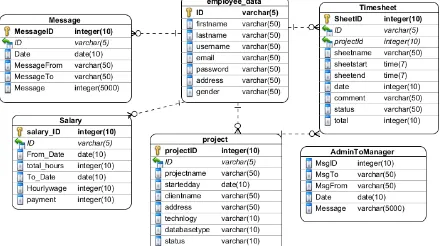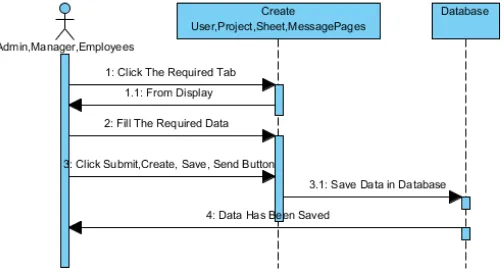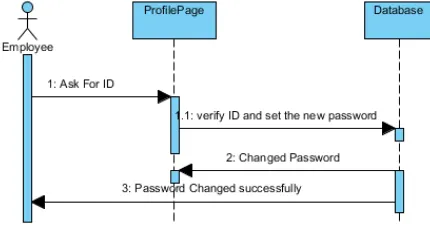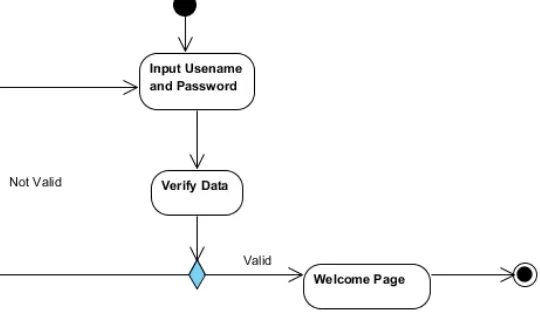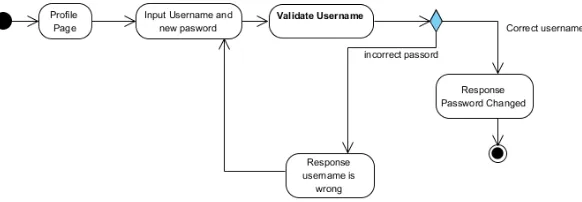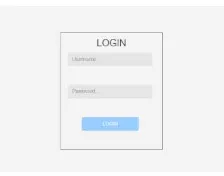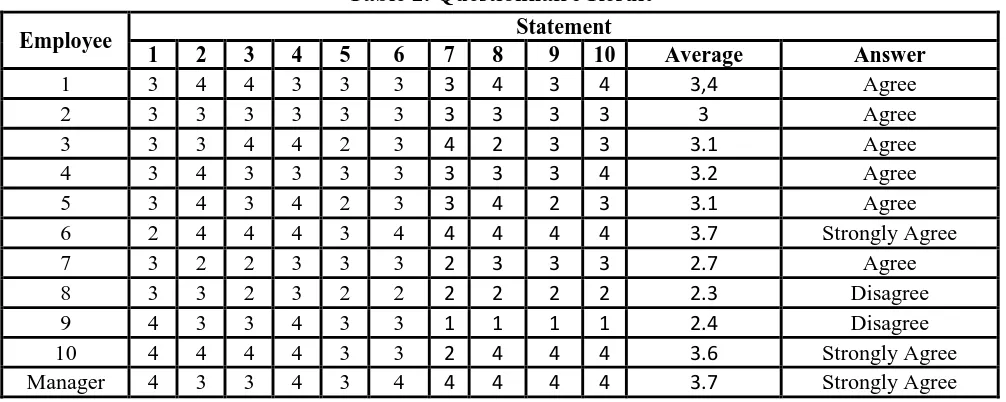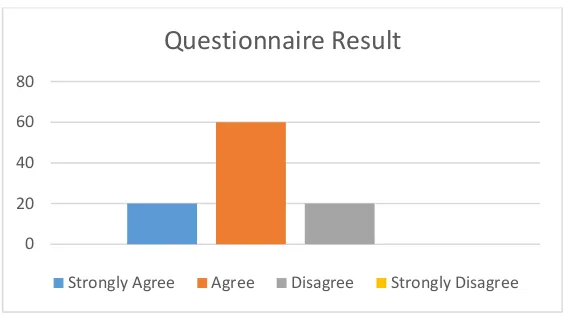WEB-BASED TIME-SHEET SYSTEM
SCIENTIFIC PUBLICATIONS
Compiled as a condition completing Bachelor Degree Program at the Department of Informatics, Faculty of Communication and Informatics
By:
MAJD ABU-SHAHEEN L 200 122 017
DEPARTMENT OF INFORMATICS
FACULTY OF COMMUNICATION AND INFORMATICS
UNIVERSITAS MUHAMMADIYAH SURAKARTA
i
PAGE APPROVAL
ii
ENDORSEMENT PAGE
v
1
WEB-BASED TIME-SHEET SYSTEM
Abstrak
Sistem lembar kerja berbasis web adalah sebuah aplikasi web yang menyediakan metode otomatis untuk mencari waktu kerja untul pegawai dengan cara aktivasi manajer untuk mencari waktu kerja para pegawai, system ini membantu dalam proyek pada pegawai secara spesifik, ini juga menghitung performa dan produktifitas, sebaik-baiknya penyediaan metode otomatis dari penghitungan gaji untuk para pegawai yang berbasis pada total waktu kerja. Sistem ini juga menyediakan komunikasi langsung antar pegawai dan manajer. Keuntungan penting lainnya dari system ini adalah setiap hak-hak yang berbeda berdasarkan pekerjaan. Di samping itu, system ini dibuat dengan asp.net, C#, Ajax dan JavaScript, dan menggunakan basis data SQL Server. Sistem lembar kerja berbasis web ini telah sukses di uji coba oleh Rami Awad Establishment dengan kepuasan yang tinggi, dengan metode kuisioner yang telah dilakukan.
Kata Kunci: Asp.net, Ajax, C#, Employee, SQL server, Time tracking, Time-sheet.
Abstract
Web-based time-sheet system is a web application that provides an automated method of tracking work time for employees by enabling the manger to track their work time, this system helps in assigning projects to specific employees, also it measures the performance and productivity, as well as providing an automated method of calculating salary for employees based on their total work time. The system, in addition, provides a direct communication among the employees and the manger. One important advantage of the system is that each employee can log into his account to do the assigned projects. An employee, a manager and an admin have different prerogatives according to their roles. Besides, the system has been built in asp.net, C#, Ajax and JavaScript, and using SQL server database. Web-based timesheet system has been successfully tested at Rami Awad Establishment with high level of satisfaction as the questionnaire results showed.
Keywords: Asp.net, Ajax, C#, Employee, SQL server, Time tracking, Time-sheet.
1. Introduction
2
to process and submit the sheet. Furthermore, the paper based time-sheet sometimes lacks credibility. Paper timesheets are also likely to error because it could be hard to distinction time data from employees that hand write their time. This causes error in transcribing the data. Another issue with paper based time-sheet is the ability to enter someone else’s time and nobody could know. This is also a method for managers to create ghost payroll, where they can make up hours for employees that no longer work there. All the problems lead to waste both of time and money.
To overcome the problems outlined above, improvements are needed in order to tackle the problems; one of the available solutions for the problems mentioned above is to create a web-based time-sheet. A web-based time-sheet is a web application that could be a great replacement for the paper based time-sheet, as this software is digital, it doesn’t occupy any physical space. Besides, paper-based timesheets occupy a lot of physical space to store. While web-based time sheet is time saving and has a high level of credibility. No one can fraud his total work hours. Besides, in the case of web-based time-sheet the total time work calculation is accurate. In the case of web-based time-sheets the mangers are not able to create the ghost payroll, a web-based time-sheet is more accurate than the paper ones. All the improvements above assure productivity, time and money saving.
The purpose of this research is to create a web-based time-sheet that would replace the paper one. The web application will be simple website in order to avoid time consumption, save money and reduce the manpower. With this systemefficiency, productivity, accuracy and agility are available.
According to James Henderson (2012) in his research titled Time and Attendance Reporting
internal control review is that the employees and supervisors have the responsibility to ensure that all hours worked are accurately reported and that the payroll is correctly calculated and paid. Good internal controls are important to assure that payroll is being properly administered. Time and attendance approvals as well as accuracy have to be the responsibility of the supervisor who should be held accountable for the employees’ time worked and absences. This control will help ensure that accurate time and attendance information is recorded and reported. The primary responsibility for authorizing and approving time and attendance transactions lies with the supervisor of the employees. The approving official acknowledges responsibility when approving the time and attendance sheet with his or her signature.
According to Fred Fuchs, Joel Vincent, Jennifer Russell and Robert Di (2004) in their research titled Timesheet Reporting and Extraction System and Method, a timesheet reporting and extraction system and method includes accepting time entry data from a first user using a computing device. The entered data is compared to a predefined work schedule and discrepancies are noted for overtime or other compensation adjustments. Timesheet information and adjustment information are organized into a file and uploaded to a server for database storage and report processing, and may be converted and output to a central processing system such as a payroll system. A second user approves timesheet entries using a second computing device.
According to Juergen Sattler and Joachim Gaffga (2006) in their research Method and System for Timesheet Reporting, Employee time reporting may be used for a business to record an employee's work performed, for example in order to bill customers for the work performed on particular tasks. Traditionally, time reporting has been done manually. For example, an employee may manually keep track of the employee's work and time spent on the work and may submit a written report, which may then be manually compiled with other time reports which employees may use to submit data for the employee's time report. However, the employee must still manually enter most of the data regarding the employee's work and time into the system. Accordingly, there is a need in the art for a quick and efficient time reporting system.
According to Praveen Krishnan, Richard Huska and Raj Narayanswamy (2015) in their research
3
of time which their employees spend at work using specially-designed time clocks. Time clocks allow employees to enter the time they start working and the time they finished the work. Time clocks generally range from mechanical clocks, which require an employee has to insert and punch a paper card, to electronic time clocks that allow employees to swipe magnetic identification cards to register times. Time clocks can be standalone hardware devices that are installed on business's premises. Time clocks typically interact with an electronic system that stores time entries that are submitted to the time clock. Such time clocks may require regular maintenance from qualified personnel.
According to SM. Budiyanto (2014) in his article titled The Summary of Human Resource Management for Language Teaching Organization better quality in HRM will be better the LTO performance, Smart and professional candidate is badly needed in this case, therefore, an accurate and honest selection should be conducted in fair way to get the best result of it. Accurate selection of candidates, cooperation, and understanding among the members of LTO; from manager, teachers, staffs, up to workers will give a great impact for the betterment of LTO.
According Susatyo Yuwono (2016) in his article titled Diversity Management and Employee Well-Being in Higher Education, Diversity becomes a necessity in today’s modern era. The phenomenon is an inevitable thing in higher education or university as the institution which produces human resources. In fact, both of the positive and negati.ve impacts of diversity in university require appropriate management. This study was aimed to reveal the dynamics of diversity management in order to improve the employees’ well-being in the university. The results of theoretical study and previous studies have shown that the diversity management emphasizes on optimal utilization of all potentials and advantages of diverse resources. The opportunity to play an optimal role for the university’s progress leads to a comfortable psychological conditions, which should be supported by all parties in the university, both leaders and staffs. The progress in the university will improve the working facilities as well as the income of individual employees. Subsequently, individual employees will encourage more prosperous family and their wellbeing as well.
2. Research Methods
The author used two methods in the proposed research. The first method is the study of librarianship by collecting and gathering information from books, articles, researches and open sources related to the topic. The second method in the field of study that is conducting interview with the CEO of Rami Awad Establishment and request a paper-based time-sheet that they use in the company; also, request a data sample they use for employees.
2.1Time and Place
The project process will start in December 2015 and is supposed to be completed by the end of June 2016. The place for the research is the University Muhammadiyah of Surakarta, classroom and library.
2.2Tools and equipment
The main equipment is divided into two categories: hardware and software. The hardware that is used in the research is manly a laptop with the following specification: Processor: Intel(R) Core(TM) i7-4510U CPU @2.00GHz 2,60GHz, memory: an 8-GB RAM. Whereas the Software applications used during the research are: Notepad++, visual studio ultimate, google chrome and SQL server management studio.
The materials used in this research are a paper based time-sheet sample and an active employees data of Rami Awad Establishment.
4
System design includes the creation of the design or the design of the system by using the diagram in the Unified Modeling language (UML). The diagrams which are used during the research are detailed below:
A. Use Case diagram
Use Case Diagram describes the functionality expected from the system and gives a graphical overview of the interaction between the user and the system as shown below:
Figure 1. Use Case Diagram admin, employee and manager.
B. Class Diagram (Entity Relationship Diagram):
Entity Relationship is a graphical representation of entities and their relationship to each other, typically used in computing in regard to the organization of data within database or information, as shown in Figure (2).
Figure 2. Entity Relationship Diagram Timesheet System
C. Sequence Diagram:
1) Login Sequence Diagram
5
will be redirected to their accounts based on the current-user-type session, there are three main types of users; Admin, Manager and Employee.
Figure 3. Sequence Diagram for login
2) Create project, create new user, create time-sheet and send message
Sequence Diagram create project, create new user, create time-sheet and send message as shown in Figure (3). The process begins when the user clicks the required tab then after that, the required form will show up, whereupon the user will be able to fill the information in the form, as soon as the user clicks the submit, save, create or send, the data will be saved into the database in the suitable table.
Figure 4. Sequence Diagram create project, create new user, create time-sheet and send message
3) Edit Sequence Diagram
6
Figure 5. Sequence Diagram Edit Process
4) Delete Sequence Diagram
The delete process begins by clicking the delete button for the row we intend to delete: once the user presses the button the data will be erased from database, as shown in Figure (6)
Figure 6. Sequence Diagram Delete Process
5) Change PasswordSequence Diagram
Sequence diagram change password displays the process to change the required login password as shown in Figure (3). The employee fills the new password and the ID, then the system will verify the ID if it exists the password will be changed successfully. If the ID doesn’t exist in the database then the employee will receive a message warning him that the ID is wrong or doesn’t not exist, as shown in Figure (7).
Figure 7. Sequence Diagram Change Password
7
Sequence diagram for Payroll shows the process to generate a payroll for each employee in specific period; the process starts once the manager fills the period, then fills the hourly wage which is the money will be paid for the employee per hour, also chooses the required employee username. After the manager fills all the data and clicks collect data the payroll will be generated directly, if the endorse that payroll, he has to click the save button then the payroll will be saved into the database. If the employee doesn’t have any timesheet then no payroll will be available, as shown in Figure (8).
Figure 8. Sequence Diagram Generate Payroll
D. Activity Diagram
Activity Diagram is a diagram that describes the dynamic aspects of the system. It is basically a flow chart representing the flow form in one activity. It can be described as an operation of the system.
1) Login Activity Diagram
Activity diagram login shows the activity log when the admin, user and manager intend to access the timesheet system as shown in Figure 8.
8 2) Create User, Project and Sheet Activity Diagram
Activity Diagram Create user, project, sheet shows the activity log when admin, manager and employee are in process to create new data, as shown in Figure (9).
Figure 9. Create User, Project and Sheet Activity Diagram
3) Delete and Edit Activity Diagram
Delete and Edit Activity Diagram shows the activity log if the Admin, Manager And\or employee would like to delete or edit data, as shown in Figure (10)
Figure (10) Delete and Edit Activity Diagram
4) Change Password Activity Diagram
Activity Diagram change the password shows the activity log if the employee would like to change the password, as shown in Figure (11).
Figure 11. Change Password Activity Diagram
2.4Implementation
The interface for the proposed system requires a login page and a profile page as a form of implementation of the web-based time-sheet system. Hopefully all the process can be done.
9
The login form is simply designed and laid in the middle of the page like usual login forms in order to simplify the login process. In this page there are two required fields: username and password, as shown in Figure (12), the login form used to validate the users are allowed to access the main page.
Figure 12. Login from
b. Profile Form
The profile page is simply designed and easy to use. In the top of the page the user type will appear based on the current user, many different menus will be laid horizontally. At the bottom of the page there will be a footer which will define the company and any contact information as shown in Figure (13).
Figure 13. Profile Form 3. Result and Discussion
3.1. Research Result
The result of the research conducted by the author is to apply the web-based time-sheet instead of the paper based time-sheet. The proposed system can be applied online on www.oneclicksheet.somee.com. According to the stages of the system, the interface of is divided into login page, admin profile, manager profile and employee profile.
a. Login Page
10
Figure 14. Login Page
b. Admin Profile
The admin main menu will appear once the admin successfully login. This page consists of a header, content and footer, the “header” section contains the type of the user who is currently logging in into the system. “Admin” as well contains the pages that the admin is authorized to access, the menu has 6 pages with different functions: home page, new employee page, employee data page, inbox page, send message page and logout. In the new employee page the admin is able to create an account for the employee to access the system, in employee data page the admin can modify and delete the user data, inbox and
message pages are for end and receive a messages among the admin, employee and manager, as shown in Figure (15).
Figure 15. Admin Profile Page
c. Manager Profile
The manager main menu will show up directly after the manager login successfully, this page contains header, content and footer, the design in all profiles is the same, the header contains the type of the user who is currently login, this profile basically contains nine pages: home, projects, timesheet, view projects, messages, payroll, salary list, inbox and logout option. These pages are authorized only by admin to access. Home page is a page to only welcome the manager once he login into the system. Projects page
is a page which gives the ability to the manager to create a projects and assign them to employees and save them. Timesheet page here is the page the admin could have for an overall view of the submitted time-sheets in order to keep an eye on the projects process. View projects page the manager can modify and\or delete the projects in case of any changes in the projects even if the manager would assign the project to another employee, this is a feature to ensure flexibility in work.
11
wage for the employee, the manager could save it by clicking save button. Salary list is the page that the manager can find the payroll he created previously in payroll page, as shown in Figure (16).
Figure 16. Manager Profile Page
d. Employee Profile
Employee profile will appear after the employee login into the system successfully, employee profile consists of: header, content and footer. The header contains the ID number of the employee as well as the current user type which is “employee”; the menu contains 6 options: home, time-sheet, profile, message, edit sheet and logout. Home page it’s the welcome page for the employee after any action in
the page the employee will be redirected to this page; time-sheet page is the page that the employee creates for his own sheet based on the project assigned by the manager, time will be calculated automatically; message is a page which provides communication among employee, manager and admin;
edit sheet: in this page, the employee is able to modify the sheet he created in order to avoid mistakes in work. As shown in Figure (17).
Figure 17. Employee Profile Page
3.2. Testing a. Questionnaire
12
The assessment of the questionnaire divided into 10 statements as shown in Table 1
Table 1. Questionnaire
No Statement Answers
SA A DA SD
1 The site’s design aesthetically appealing.
2 The colors used harmonious and logically related
3 No obvious security flaws
4 The site loads quickly
5 The scripts free from errors.
6 The web-site meets all your needs
7 The web-site is easy to deal with
8 The web-site is a good replacement for the paper timesheet.
9 The web-site is a good system to avoid time consuming.
10 The web-site is a good tool to communicate with manager.
Description of table 1.
Strongly Agree (SA) = 4, Agree (A) = 3 Disagree (D) = 2, Strongly Disagree = 1
The system has been tested by 10 employees and one manager who have done the evaluation by filling the questionnaire. The result as shown in Table 2.
Table 2. Questionnaire Result
Average percentage of respondents answers regarding the statements on questionnaire as follow.
13
Figure 18. Result graph for employees’ questionnaire
b. Black Box Test
The second method which the author used for testing is black box method; the aim of this testing method is to examine the functionality of the system without peering into internal structure or work. The author tested the system in accordance with testing procedures as shown in Table 3; ensure that the entire functions of the system are running properly. Therefore, it can be ascertained that the website does not have any logical errors, Further, the testing process has been done in different web browser.
The proposed system has been tested in a different type of web browser such as google chrome, Mozilla Firefox, and Opera; to determine whether the system working properly in all browser, as shown in Table 4.
Table 3. Black Box Testing Method
No Description Testing Procedure Output
Result Very
Good Good Bad
1 Login Fill Sign Up Form( Input Name, Weight, height,
and Password) and Klick Start Button
user Fill the registration form and click create
User has been created
successfully √
3 Edit user data and delete user account
Edit some data and click update, delete user account and click delete
Data has been edited, user
has been deleted √
4 Send message Fill the message form and click send Message has been sent √
5 Create project Fill the project information form and click create Project has been created √ 6
Edit project, delete project
Edit the required project data and click update, delete the selected project
Data has been edited,
project has been deleted √ 7 Generate payroll
Fill the payroll form ( period time, employee id,
hourly wage, date) and click generate Payroll has been generated √
8 Save payroll After payroll been generated click save Payroll has been saved √
9 Create Timesheet Fill the timesheet form and click create Sheet has been created √
10 Change password Fill the required data ( ID, new password) and click change
Password has been
changed √
11 Edit sheet, delete sheet
14
Based on testing using questionnaire method, satisfaction was obtained from employees and manager as shown in Table 2. From these results it can be concluded that; the system is acceptable by most of the employees and most of them are satisfied with it.
The web-based timesheet has several advantages; the data being saved automatically with no time consuming, also the system avoids data losing and it prevent fraud timesheet; the system is designed attractively and is easy to interact with it even for employees who have little or no knowledge about technology. However, this system is still not fully prepared to implement in the companies who have different departments, managers and employees level, nevertheless, it could be very helpful for the small companies. In addition, the system could be developed to suit all the companies.
4. Conclusion
Time-sheet is an essential part in every company nowadays, it’s a reliable proof for employees and managers; it’s now required in all company. However, most companies use the paper-based time-sheets; but in the time of technology development, paper-based time-sheet is a waste of time and money, employees and managers should go through several stages to perform paper timesheet, as this process consume time it can result in ineffectiveness in work as well as in inaccuracies in data. So this web-site resolves the issue of time wasting, ineffectiveness and inaccuracies by using a web-based time-sheet. Web-based time-sheet has been done by conducting needs analysis, by studying theories about time management and programming language suitable for time tracking. In addition to gathering data related to paper time-sheets. After that began with system design that started with identification the user, then proceeded with creating diagram in UML (Unified Modeling Language); after design process it proceed to build the system using Visual Studio, the system continues to testing stage by testing the system directly in the work field, testing process has been successfully conducted in Rami Awad Establishment. Furthermore, this system could be developed and improved to be suitable for the companies who have different functional division.
The result of the questionnaire indicates that 60% agree with system. So, it can be concluded that the proposed system is a good potential replacement for the paper-based time-sheet. Based on the high level of satisfaction among the employees and manager the system will reduce time consuming and money waste.
5. Acknowledgment
15
Umi Fadillah, S.T, M.Eng. For her supervision and constant support. Her invaluable help of constructive comments and suggestions throughout the experimental and research works have contributed to the success of this research. Not forgotten, my appreciation to Dr.Heru Supriyno, M.Sc. Principal of the Faculty, for providing me with all the necessary facilities for the research.
My acknowledgement also goes to all the technicians and office staffs of Informatics Faculty. Sincere thanks to all my friends and others for their kindness and moral support during my study. Thanks for the friendship and memories.
Last but not least, my deepest gratitude goes to my beloved parents, uncle and grandfather; Mr. Hasan Shaker, Mrs. Manal Soud, Mr. Rami Awad, Mr. Soud Awad and also to my brothers and sister for their endless love, help, support, prayers and encouragement. I also would like to express my gratitude to those who indirectly contributed in this research, your kindness means a lot to me. Thank you very much.
6. References
Evjen, B. Hanselman, S. Rader, S (2010); Professional ASP.NET 4 in C# and VB, 1st.
Evjen, B. Gibbs, M. Wahlin, D. Reed, D (2009); Professional ASP.NET 3.5 AJAX, 1st.
Fred Fuchs, Joel Vincent, Jennifer Russell and Robert Di (2004) Timesheet Reporting and Extraction System and Method. Retrieved: From https://www.google.com/patents/US20040019542.
Hume, D.A. (2013); Fast ASP.Net Website, 1st.
James Henderson (2012) Time and Attendance Reporting Retrieved From: http://link.springer.com/article/10.1007/s10549-011-1738-1.
Juergen Sattler and Joachim Gaffga (2006) Method and System for Timesheet Reporting. Retrieved From: https://www.google.com/patents/US20060015361.
Ruvalcaba, Z. (2008); ASP.NET Website Using C# and VB, 1st.
Stellman, A. Greene, J. (2013); Head First C#, 3rd Edition.
Spaanjaars, I.(2010); Beginning ASP.NET 4 in C# and VB.
Susatyo Yuwono (2016). Diversity Management and Employee Well-Being in Higher Education Journal. Surakarta: Faculty of Psychology Universitas Muhammadiyah Surakarta.
SM. Budiyanto (2014). The Summary of Human Resource Management for Language Teaching Organization Journal. Surakarta: FKIP, Universitas Muhammadiyah Surakarta.
